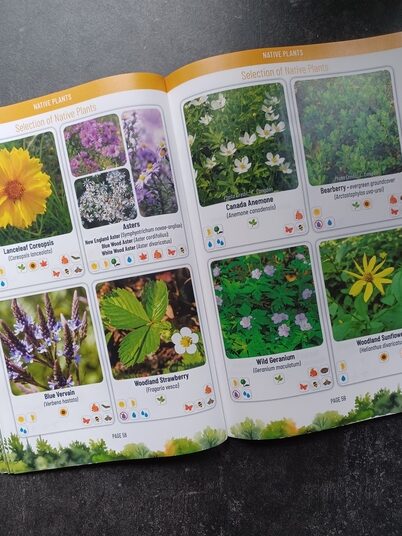
Ecological Landscaping in Haliburton County: New Guide Tells You What You Need to Know
Ecological landscaping – or natural gardening – is becoming a thing here in Haliburton County. I couldn’t be more excited! This new guide from Haliburton County Master Gardeners provides an excellent overview of what ecological landscaping is – and how you can transform your landscape into something that’s beautiful to you and to the rest of nature.
How lucky we are to have master gardeners in the Highlands that get it! Haliburton County is a place that tries to respect nature, and the methods of landscaping our local gardening experts espouse in this new book, Guidebook to Ecological Landscaping in the Highlands, do just that.
First steps to ecological landscapes

The book begins with the extremely important steps of defining our landscape. After all, if we are to choose “right plant in very right place”, we need to know what’s right for Haliburton County. It then swiftly moves on to a discussion of what is attractive, with the understanding that beauty is more than flower-deep. When we go beyond pretty, we’re serving biodiversity.
Making changes to your landscape – and maybe even to the way you think about your landscape – can be challenging. The guide tells you where to start – how to take an inventory of your property. It reminds you that you don’t have to do it all at once. Baby steps are good steps.
There’s an important section on invasive plants: which ones to watch out for and which plants you can use to replace them. If all you do is remove invasive plants, you’ve already made a big step towards creating a more balanced ecological landscape for Haliburton.
The “how to start” section ends with information on how to plant and care for your plants, as well as maintenance tips. If you’re new to gardening, all the rules can sound overwhelming. The book does a good job of reminding us that everything we need to know is already there in nature. For example, Haliburton County is littered in…err… leaf litter. So it’s OK to leave (ha!) leaf litter in our gardens too.
Creating landscapes for wildlife in the Highlands
Next is a section on habitat creation. I was pleased to see it starts with forests. After all, Haliburton County is mainly forested, which doesn’t always translate well to what we consider a garden landscape. There are some terrific plant lists for all layers of the forest, from canopy down to groundcovers.
Next comes shorelines – their health is vital yet they’re under pressure from cottage development and landscaping that can sometimes harm the lake. There’s some detailed information here, but the bottom line is plants is where it’s at: they serve so many purposes.
Wetlands come next. These hugely important habitats are overlooked as parts of a residential landscape. But they needn’t be! Some of Haliburton County’s most interesting species are wetland plants.
Finally come pollinator meadows. This type of habitat is what is mostly seen in the natural gardening world (and it’s what we’ve planted at Lucas House in Haliburton) because it’s the most easily created from a lawn.
What’s great about the guide’s choice of habitats is that they’re all relevant to pretty much every home or cottage in Haliburton County. Cottages have shorelines, they have septic tank leach beds (great for meadows), and they’re surrounded by forest, so why not blend that habitat into your own landscape?
Of mosquitos and geese

Nobody loves being bitten by mosquitos and blackflies, and they don’t like Canada geese taking over their lawns. So all too often, the solution is to remove them, often with toxic chemicals. I’m delighted the book talks about the importance of co-existing with the insects we might not love. After all, it’s in our best interests. And when it comes to geese – well, we’re our own worst enemy there. Geese love lawns. So you know what the solution to your goose problem is!
Getting our hands in the soil
The last part of the book gets down to details, starting with a sensible staged approached to ecological landscape design along with details of some representative native plants. The book includes some all-important keystone plants – use them and you get the greatest bang for your ecological landscaping buck.
This book is a great companion. It’s a way to get some dirt under your fingernails by reading an overview of what ecological landscaping in Haliburton County involves. It gives sensible practical steps and, on the final pages, provides resources (including us here at Grounded) to help you get started.
Grounded is delighted to have some of copies of the Guidebook to Ecological Landscaping in the Highlands for sale at Lucas House, in Haliburton Village. Just email us at hello@groundedgardens.ca if you want one and we’ll put one by. The price is $10 – and worth every penny.
by Simon Payn
